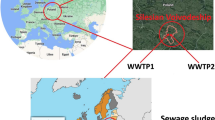Abstract
The use of sewage sludge, generated during wastewater treatment, as an organic fertilizer has attracted more attention in view of soil amendment and nutrient supplying (Antolin et al. in Field Crops Res 94(2–3):224–237, 2005) and at the same time to reduce the use of chemical fertilizers (Passuello et al. in POP accumulation in the food chain: Integrated risk model for sewage sludge application in agricultural soils 36(6):577–583, 2010).
Access this chapter
Tax calculation will be finalised at checkout
Purchases are for personal use only
Similar content being viewed by others
References
Antolin MC, Pascual I, Garcia C, Polo A, Sanchez-Diaz M. Growth, yield and solute content of barley in soils treated with sewage sludge under semiarid Mediterranean conditions. Field Crops Res 2005;94(2–3):224-237.
Bedoui A, Tigini V, Ghedira K, Varese G-C, Chekir-Ghedira L. Evaluation of an evetual ecotoxicity induced by textile effluents using a battery of biotests. Environ Sci Pollut Res. 2015.
Belhaj D, Jaabiri I, Turki N, Azri C, Kallel M, Ayadi H. Descriptive and multivariable analysis of the water parameters quality of Sfax sewage treatment plant after rehabilitation. IOSR J Comput Eng. (IOSR-JCE) e-ISSN: 2278-0661, p- ISSN: 2278-8727. 2014;16(1):81–91. Ver. VII.
Chiochetta C-G, Cotelle S, Masfaraud J-F, Toumi H, Quaranta G, Adani F, Radetski C-M. Use of ago-industrial organic sludge amendment to remediate degraded soil: chemical and eco(geno)toxicolgical differences between fresh and stabilized sludge and establishment of application rates. Environ Sci Pollut Res. 2015.
Passuello A, Mari M, Nadal M, Schuhmacher M, Domingo J-L. POP accumulation in the food chain: Integrated risk model for sewage sludge application in agricultural soils. 2010;36(6):577–583.
Quillardet P, Hofnung M. The SOS Chromotest, a colorimetric bacterial assay for genotoxins: procedures. Mutat Res. 1985;147:65–78.
Svensson B-M, Mathiasson L, Martensson L, Bergstrom S. Artemia salina as test organism for assessment of acute toxicity of leachate water from landfills. 2005.
Author information
Authors and Affiliations
Corresponding author
Editor information
Editors and Affiliations
Rights and permissions
Copyright information
© 2018 Springer International Publishing AG
About this paper
Cite this paper
Jerbi, B. et al. (2018). Eco (Geno) Toxic Assessment of Urban Sewage Sludge from Sfax Wastewater Treatment Plant. In: Kallel, A., Ksibi, M., Ben Dhia, H., Khélifi, N. (eds) Recent Advances in Environmental Science from the Euro-Mediterranean and Surrounding Regions. EMCEI 2017. Advances in Science, Technology & Innovation. Springer, Cham. https://doi.org/10.1007/978-3-319-70548-4_149
Download citation
DOI: https://doi.org/10.1007/978-3-319-70548-4_149
Publisher Name: Springer, Cham
Print ISBN: 978-3-319-70547-7
Online ISBN: 978-3-319-70548-4
eBook Packages: Earth and Environmental ScienceEarth and Environmental Science (R0)




